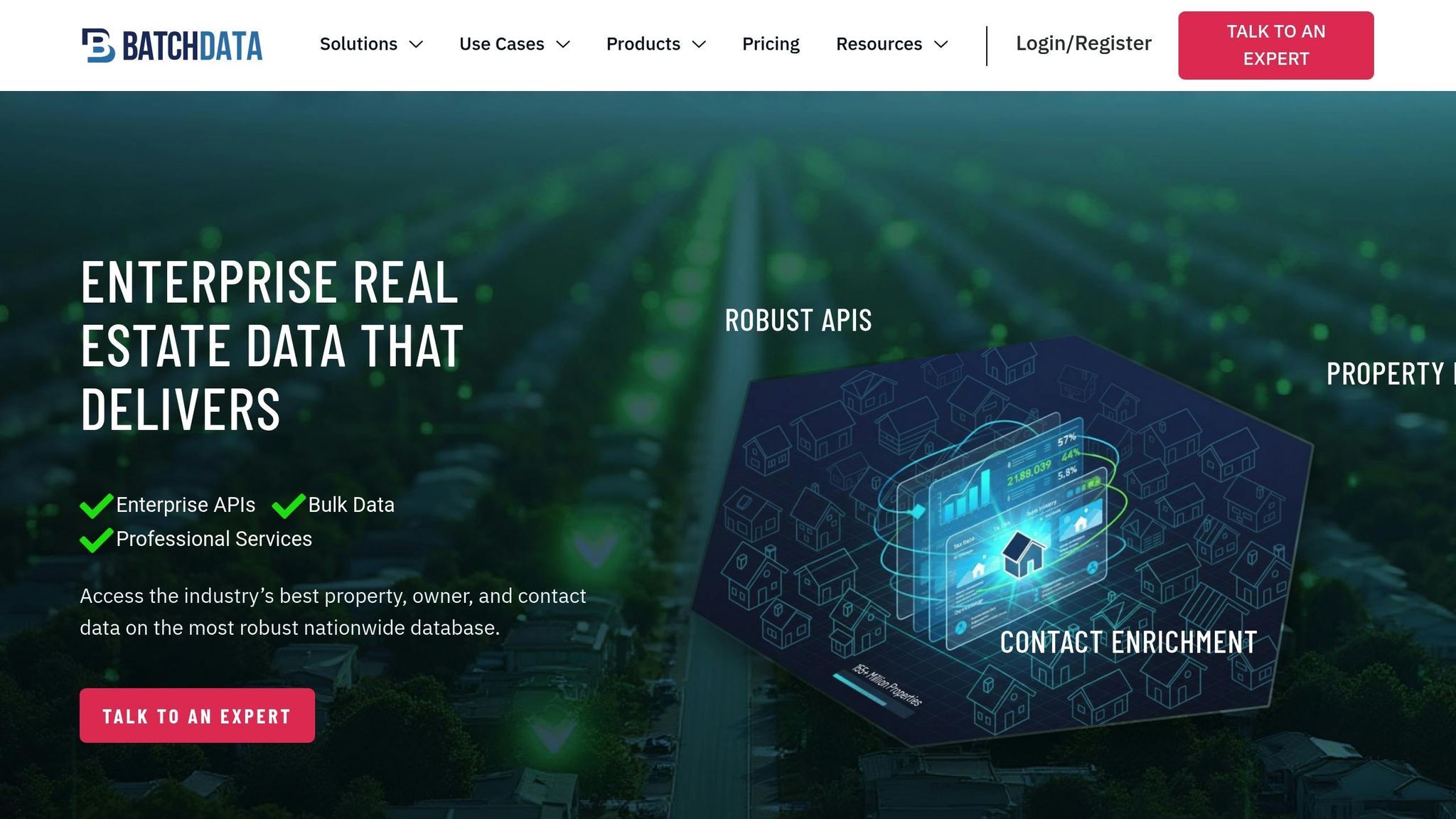Bulk skip tracing is a powerful tool for real estate professionals to save time and money. Instead of manually searching for property owner details one at a time, bulk skip tracing processes thousands of records at once, delivering accurate contact information quickly and efficiently. This method is especially helpful for wholesalers, fix-and-flip investors, and anyone working with large property lists.
Key Benefits:
- Lower Costs: Bulk processing reduces per-record costs to as low as $0.009, compared to $0.75–$1.50 for single-record tracing.
- Time Savings: Automated systems process thousands of records in hours, not days, cutting labor expenses significantly.
- Higher Efficiency: Integrated services combine property data, contact verification, and skip tracing in one streamlined process.
Bulk skip tracing allows professionals to focus on closing deals instead of wasting time on repetitive tasks. With the right provider, such as BatchData, you can further reduce costs with pay-as-you-go pricing, API integrations, and bundled data services. By optimizing your workflow and eliminating inefficiencies, bulk skip tracing becomes a cost-effective way to stay ahead in competitive markets.
Main Cost Problems with Single-Record Skip Tracing
High Labor and Time Expenses
Single-record skip tracing can be a major drain on both time and resources. When real estate professionals search for property owners one record at a time, they often find themselves stuck in repetitive manual tasks, like cross-referencing multiple sources. This process isn’t just tedious – it also drives up labor costs significantly.
Scattered Data Management
Managing data without a centralized system can be a costly headache. When information is spread across different files and formats, it’s all too easy to miss important details or make mistakes. These errors can lead to rework, which only adds to the inefficiency. Instead of focusing on productive research, teams often spend hours just organizing and cross-referencing data. This inefficient workflow not only slows things down but also increases the risk of revenue losses.
"Sifting through large amounts of unorganized data manually is a significant waste of time and effort that organizations cannot afford", explains Sarah Englund, Debt Collector/Recovery Specialist at Professional Service Bureau.
Lost Revenue from Slow Processing
Delays in processing can mean missing out on key real estate opportunities. When the process drags on, it can delay deal engagement, which directly impacts revenue. On top of that, working with outdated or inaccurate information from scattered sources wastes valuable time and resources.
Up next, we’ll take a closer look at how bulk skip tracing addresses these challenges.
How Bulk Skip Tracing Cuts Costs
Volume Discounts and Lower Per-Record Costs
Bulk skip tracing offers a cost-effective solution by significantly lowering the cost per record. While traditional skip tracing can range from several cents to a few dollars per record, bulk processing can reduce these costs to as little as 3¢ per record, with most services falling between 3¢ and 7¢. For smaller lists, a flat minimum fee of around $0.70 may apply. For larger datasets, costs can drop even further, with some API-based services charging as little as $0.009 per successful call.
Some providers go a step further by including skip tracing as part of subscription packages, effectively bringing the per-record cost to zero. This combination of bulk pricing and automation creates opportunities for even greater savings.
Automated Processing Reduces Manual Work
Automation is a game changer when it comes to cutting costs. Instead of requiring staff to manually sift through databases and cross-reference information, bulk skip tracing systems handle massive datasets automatically, with no human intervention needed.
By automating these processes, businesses can reduce staffing needs while freeing up employees to focus on higher-value tasks like qualifying leads or negotiating deals. What once took days or weeks can now be completed in just a few hours, saving time and reducing operational expenses. Automation also minimizes costly errors, which means less rework and faster market entry. Plus, when combined with integrated data services, the savings multiply.
Combined Data Services in One Process
Bulk skip tracing platforms often bundle additional data services, which can lead to even more savings. Instead of paying for separate tools for property data, contact verification, and skip tracing, many platforms combine these functions into a single, streamlined process.
Take BatchData as an example: it offers property and contact data enrichment, skip tracing, phone verification, and bulk data delivery through unified APIs. This integrated approach not only reduces direct costs but also simplifies data management by consolidating everything into one workflow.
You’re Wasting Money on Skip Tracing – Here’s a Smarter Way
sbb-itb-8058745
Methods to Maximize Cost Savings
Building on the cost-saving benefits of bulk skip tracing, you can adopt a few additional strategies to stretch your budget even further.
Clean Your Data Before Processing
Start by cleaning up your property lists to avoid unnecessary costs from duplicate records, failed searches, or extra fees. This means removing duplicates, standardizing addresses according to USPS guidelines, fixing typos, and verifying phone numbers. Taking these steps can improve match rates and help keep processing fees low.
Double-check entries for consistent formatting to ensure accuracy.
"Company Skips – These are caused by a clerical error when data is entered. If an address or other personal information is entered incorrectly, it can be difficult to locate individuals. This can be minimized by scanning documents so they are easy to refer to later. Also be sure to train collectors to review documents thoroughly."
– PDCflow Blog
Select the Right Data Provider
Choosing the right skip tracing provider is key. Look for one with transparent pricing, broad data coverage, and FCRA compliance. Providers should also be evaluated based on match rates, how fresh their data is, and their pricing structure.
For businesses managing high volumes, API-based solutions can be a game-changer. They streamline operations, cut down on manual work, and often offer better value. For example, BatchData’s pay-as-you-go model eliminates subscription fees, allowing you to pay only for the data you actually use. This is especially helpful for businesses with variable monthly needs. Additionally, working with a provider that bundles multiple services can simplify vendor management and further reduce your overall data costs.
Use API Connections for Better Workflow
Integrating APIs into your workflow can save both time and money by automating skip tracing processes. APIs eliminate the need for manual uploads and reformatting, making operations smoother and more efficient.
Real-time API processing ensures you’re working with the most up-to-date information by handling skip tracing records as they come in, rather than batching them for later. This can also help cut down on storage costs. Plus, APIs improve error handling by automatically retrying failed searches, further reducing expenses.
For larger campaigns, bulk delivery APIs can process thousands of records simultaneously while maintaining data security and compliance. This scalability ensures that per-record costs stay consistent as your volume increases.
By combining these methods with bulk skip tracing, you can significantly reduce operational costs while improving efficiency.
"Attention to detail is crucial when collecting, recording, and analyzing information. Skip Tracers must also maintain accurate records and documentation for legal and ethical purposes."
– ZipRecruiter
Practical Examples and Cost Results
Across the U.S., bulk skip tracing is proving to be a game-changer for businesses, especially when it comes to cutting costs. Let’s dive into some common use cases and the financial impact.
Typical Business Uses
One of the most profitable uses of bulk skip tracing is absentee owner campaigns. Here’s how it works: investors purchase lists of 5,000–10,000 property records and use bulk skip tracing to update contact information for property owners who no longer live at their investment properties. These absentee owners are often motivated sellers, eager to part with rental properties or inherited homes.
Another high-value application is pre-foreclosure lead generation. Investors process courthouse records in bulk to identify homeowners facing foreclosure. By skip tracing these records, they can contact distressed property owners before competitors, creating opportunities for wholesale deals or direct purchases.
Off-market property sourcing is another area where bulk skip tracing shines. Investors can identify owners of vacant properties, expired listings, or homes with code violations. By processing these records in batches of 1,000 or more, they can efficiently reach property owners who might be ready to sell but haven’t listed their properties publicly.
For those targeting probate and estate properties, bulk skip tracing can identify heirs or estate administrators after processing court records of recently deceased property owners. While this approach requires a delicate touch, it often uncovers properties that heirs are eager to sell quickly.
Each of these strategies not only streamlines operations but also delivers measurable financial benefits.
Actual Dollar Savings
The cost savings with bulk skip tracing are substantial. Let’s break it down. Single-record skip tracing typically costs between $0.75 and $1.50 per record. But when you process records in bulk (1,000 or more), the cost drops to $0.25 to $0.50 per record.
For example, if you process 5,000 records per month, single-record tracing at $1.00 each would cost $5,000. In contrast, bulk processing at $0.35 per record costs $1,750. That’s a yearly savings of $39,000! And it’s not just about the tracing costs – labor expenses drop significantly too. Manually processing records takes 3–5 minutes per record, but bulk automation slashes this to under 30 seconds. For a team member earning $25 per hour, manually processing 1,000 records costs $1,250 in labor. Bulk automation reduces this to roughly $200, saving $1,050 per batch.
On top of that, fresher and more accurate data from bulk skip tracing providers leads to better conversion rates. With higher match rates, you’ll waste less on undeliverable mail or disconnected phone numbers, making your marketing dollars go further.
BatchData‘s Cost-Saving Solutions

BatchData offers a range of solutions designed to maximize savings for real estate professionals. Their pay-as-you-go model, combined with bulk data delivery, API integration, and real-time processing, slashes processing time and labor costs while ensuring data accuracy and compliance. This approach is particularly helpful for businesses with fluctuating skip tracing needs, as it eliminates the burden of monthly subscription fees.
BatchData also simplifies vendor management by consolidating multiple data types – property records, contact details, and phone verification – into one platform. This often leads to volume discounts and reduced overhead.
Their real-time processing ensures you’re working with the most up-to-date information, boosting contact rates and cutting down on wasted marketing spend. Plus, their developer-friendly APIs allow seamless integration with CRM systems and marketing tools, further reducing manual work and associated costs.
For those with unique data needs, BatchData offers customized solutions through professional services. This means you can access tailored, enterprise-quality data solutions without the hefty expense of building in-house capabilities. It’s a flexible, cost-effective way to scale your operations without breaking the bank.
Conclusion: Why Bulk Skip Tracing Saves Money
Switching from single-record processing to bulk operations isn’t just about convenience – it’s about unlocking significant savings that can make a real difference to your bottom line.
The secret lies in operational efficiency. Automated bulk processing turns tasks that used to take minutes into something that’s done in seconds. This means your team can focus on what really matters: turning leads into deals and negotiating contracts.
Accuracy plays a huge role too. BatchData’s skip tracing boasts a 76% success rate in reaching property owners – three times higher than the industry average. This level of precision cuts down on wasted time and effort chasing contacts that go nowhere.
Then there’s scalability. With pay-as-you-go pricing, you’re not stuck with subscription fees or hidden charges. As your needs grow, your costs stay under control, making it easier to manage expenses without sacrificing performance.
For real estate professionals, bulk skip tracing isn’t just a way to save money – it’s a smart strategy. By lowering processing costs, cutting labor expenses, improving data accuracy, and automating workflows, it gives you a competitive edge that drives profitability. BatchData’s solutions bring all these benefits together, helping you streamline operations while staying agile and cost-effective.
FAQs
How does bulk skip tracing enhance data accuracy compared to processing individual records?
Bulk skip tracing improves data accuracy by using advanced tools and combining information from multiple trusted sources. This approach helps eliminate errors from outdated or incomplete data, making it easier to correctly match contact details to the right individuals.
Handling large datasets in bulk also reduces the risk of manual mistakes and keeps records consistent, boosting overall accuracy. This method is not just time-saving – it delivers dependable results for your data requirements.
What should you look for in a bulk skip tracing provider?
When choosing a bulk skip tracing provider in the U.S., prioritize data accuracy, legal compliance, and dependability. Look for a provider that sources information responsibly, complies with all privacy regulations, and consistently delivers reliable results.
It’s also important to evaluate their capacity to handle large data volumes efficiently, offer tailored solutions to meet your unique requirements, and provide prompt, helpful customer support. These elements are key to accessing affordable and efficient skip tracing services that help streamline your efforts and reduce costs.
How does using APIs in skip tracing improve efficiency and reduce costs?
Using APIs in skip tracing streamlines the entire process, making it faster and more cost-effective. By automating the retrieval and analysis of data, APIs eliminate the need for lengthy manual searches, which not only saves time but also lowers operational expenses.
With real-time access to vast and reliable databases, APIs make it easier to quickly and accurately locate individuals. This automation reduces manual workload, improves recovery rates, and helps businesses cut costs while achieving better results.



